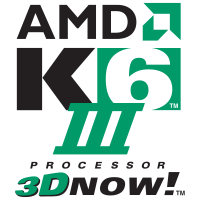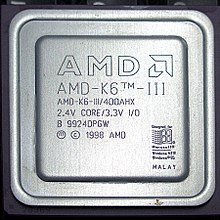AMD K6-III
| << AMD K6-III >> | |
|---|---|
 AMD K6-III logo |
|
| Production: | 1999 to 2000? |
| Producer: | AMD |
| Processor clock: | 400 MHz to 570 MHz |
| FSB cycle: | 95 MHz to 100 MHz |
| L2 cache size: | 128 KiB to 256 KiB |
| Instruction set : | x86 |
Names of the processor cores:
|
|
The K6-III is an x86 - microprocessor from AMD . It is one of the fastest processors available for socket 7 . The K6-2 + and the K6-III + were also developed on this basis.
technology
Like its predecessor, the K6-2 , the K6-III also has a 64 KiB L1 cache . With the L2 cache, the K6-2 was still dependent on the relatively slow and non-exclusively linked cache on the motherboard , which brought performance disadvantages compared to the Intel Pentium II and the Mendocino-Celeron from Intel. With the K6-III, AMD therefore decided to provide the L1 cache with an exclusively connected L2 cache on the CPU chip operated at full CPU speed. The K6-III degraded the cache on the motherboard, so to speak, from the L2 cache (on the AMD K6 , AMD K6-2, Cyrix 6x86 and Pentium ) to the L3 cache .
In addition, the L2 cache of the K6-III can temporarily store memory entries from the entire 4 GiB address space. One also speaks of a cacheable area of 4 GiB. Due to the technical and strategic market restrictions of many Socket 7 motherboards and chipsets , this cacheable area for the caches on the motherboard is rarely larger than 512 MiB , mostly only 256, 128 or even - as in the case of the Socket 7 chipset i430TX from Intel - only 64 MiB. If the memory is expanded beyond the limit of the cacheable area, the overall performance of the system still drops considerably with the K6-2. However, since the cache on the motherboard becomes the L3 cache when a K6-III is used, such drops are practically no longer measurable with the K6-III.
With 21.4 million transistors, the K6-III was a challenge for the technology available in 1999. The chip was very large, the yield was correspondingly low and operation at more than 450 MHz was rarely possible, which is why the K6-III was only offered with a maximum clock frequency of 450 MHz.
Regardless of this, it sold quite well. The K6-III was particularly popular as an upgrade CPU, as it could be used to achieve significant increases in speed, even on older motherboards. AMD accommodated this with the fact that the K6-III interprets the multiplier setting 2 as multiplier 6. There were also special CPU adapter sockets with their own voltage converters and jumpers for setting the multipliers in specialist shops. With the help of such intermediate sockets - possibly also through modifications - a K6-III could be operated with 400 MHz on almost all Socket 7 - or even Socket 5 main boards, if the BIOS allowed it. For motherboards, the manufacturers of which did not officially offer any support, technology enthusiasts partially corrected this deficiency in the BIOS using so-called unofficial patches .
Competition and market situation
As a competing product, Intel launched the Pentium III , a revised version of the Intel Pentium II . The main difference was the introduction of the instruction set extension KNI ("Katmai new instruction"), which later operated under the name ISSE and was finally called SSE . As with the introduction of MMX , SSE did not bring any advantages at first, as software that could have gained speed advantages from these instruction set extensions first had to be adapted or written.
Both companies tried hard to gain a clear lead. In general, the Intel CPUs were considered superior in floating point calculations at the time , while the K6-III was considered faster in integer calculations. Since floating-point calculations were then rarely used in conventional applications (Office, games), you had the design of the FPU decided the K6 for a slower solution, but a smaller footprint on the The had. The FPU performance suffered as a result, which made the Pentium III the better choice for scientific calculations.
With the introduction of the Athlon , the K6-III became obsolete. On the one hand, it was no longer AMD's top model, on the other hand, its production required considerable resources: With 21.3 million transistors, it was almost as expensive to produce as an Athlon with 22 million. Therefore, AMD reduced the production capacities for the K6-III considerably. The K6-III became a hard-to-get product.
However, it was only finally discontinued when Intel presented the Coppermine , an improved Pentium III CPU that had an "on-die" cache like the Mendocino-Celeron and the K6-III. At the same time, Intel changed the manufacturing process from 0.25 to 0.18 µm, which was associated with great difficulties and led to a worldwide shortage of Intel CPUs for more than 12 months. At this time, some manufacturers who had previously only installed Intel CPUs began to build Athlon systems, which was using AMD's manufacturing capacity. AMD was thus forced to finally discontinue the K6-III.
K6-2 + and K6-III +
At the end of the global CPU shortage, AMD developed revised versions of the K6 family: the K6-2 + and the K6-III +. Essentially, both processors were variants of the K6-III (the K6-2 + with 128 KiB cache, the K6-III + with the full 256 KiB cache), manufactured in a new production process (0.18 µm structure size) and expanded with "Extended 3DNow! " and " PowerNow! " CPU instructions. Although they were actually intended for notebooks , they were also built into desktop computers . However, these CPUs were difficult to obtain on the market because AMD mainly supplied them to system integrators and OEMs . AMD's marketing continued to focus on the Athlon, which is why these two CPUs were mostly known to experts and insiders, especially overclockers . A popular CPU, for example, was the K6-III + / 450, which could often be overclocked up to 600 MHz.
power
In retrospect, the K6 and its derivatives were a double-edged sword for AMD in terms of performance. Due to its slow floating point unit (because it does not have a pipeline ), the K6 does not stand a chance against its direct competitors, the Intel processors Pentium MMX and Pentium II , in FPU-heavy applications such as the then emerging 3D games. In addition, the Pentium II could access the fast L2 cache directly on the processor module, while the processors of the K6 and K6-2 series still used the L2 cache of the (super) Socket 7 mainboard. This bandwidth disadvantage made to create the AMD CPUs, only the K6-III and the mobile versions K6-2 + and K6-III + ran at the end of K6 era thanks to the The integrated Level 2 cache to top form. These clearly show the advantages of the K6 architecture: A fast integer unit with a very short pipeline, an intelligent branch prediction unit and a translation lookaside buffer that was very large for the time, gave it a high level of efficiency ( instructions per cycle ). In a test against the successor architecture K7 with the same clock frequency, the K6-2 + emerged as the winner in many integer-heavy benchmarks. But while the only six-stage integer pipeline made the K6 design largely independent of software optimizations, on the other hand, this low-latency design significantly limited the maximum clock frequency: the K6 architecture reached its maximum at 570 MHz, while the successor K7 design over-scaled the years to well over 2 GHz.
Model data
K6-III (-P) "Sharptooth" (K6-3D +)
CPU for the desktop and mobile segment.
- K6-III: Desktop CPU
- K6-III-P: CPU for mobile devices
- CPU ID: AuthenticAMD Family 5 Model 9
- L1 cache: 32 + 32 KiB (data + instructions)
- L2 cache: 256 KiB with CPU clock
- MMX , 3DNow
- Super socket 7
- Front Side Bus : 100 MHz
- Operating voltage (VCore): 2.0 - 2.4 V.
- Power consumption: 18.10 - 29.50 W.
- Release DATE: February 22, 1999
- Manufacturing technology: 0.25 µm
- The size: 118 mm² with 21.3 million transistors
- Clock rates
- K6-III: 400 and 450 MHz
- K6-III-P: 333, 350, 366, 380, 400, 433, 450 and 475 MHz
Note: The 333 MHz and 475 MHz versions of the K6-III-P are undocumented.
K6-2 +
- CPU ID: AuthenticAMD Family 5 Model 13
- L1 cache: 32 + 32 KiB (data + instructions)
- L2 cache: 128 KiB with CPU clock
- MMX , Extended 3DNow , PowerNow!
- Super socket 7
- Front side bus : 95 - 100 MHz
- Operating voltage (VCore): 2.0V
- Release DATE: April 18, 2000
- Manufacturing technology: 0.18 µm
- Clock rates: 350, 400, 450, 475, 500, 533, 550 and 570 MHz
K6-III + and K6-IIIE +
CPU for the mobile and embedded segment.
- K6-III +: CPU for notebooks etc. a.
- K6-IIIE +: embedded CPU
- CPU ID: AuthenticAMD Family 5 Model 13
- L1 cache: 32 + 32 KiB (data + instructions)
- L2 cache: 256 KiB with CPU clock
- MMX , Extended 3DNow , PowerNow!
- Super socket 7
- Front side bus : 95 - 100 MHz
- Operating voltage (VCore)
- K6-IIIE +: 1.6 V; 1.7 V; 1.8 V for “low voltage” models and 2.0 V for standard types
- K6-III +: 2.0V
- Release DATE: April 18, 2000
- Manufacturing technology: 0.18 µm
- Clock rates
- K6-IIIE +: 400, 450, 500 MHz and 550 MHz
- K6-III +: 400, 450, 475, 500 and undocumented 550 MHz
See also
Web links
- AMD product information about K6-2 to K6-III + ( Memento from February 25, 2008 in the Internet Archive )
- Detailed overview of the different versions
- K6plus - Website from K6 enthusiasts with reviews, downloads and assistance
- CPU Upgrade: Getting the AMD K6-2 + / K6-III + to work on your Super Socket 7 board
- pc-atrium, information and pictures about K6-III processors
Individual evidence
- ↑ Matthew Witheiler: Super7 Upgrade Guide: The K6-2 + and K6-3 + Processors ( English ) AnandTech . January 24, 2001. Retrieved May 21, 2012.
- ↑ Jan Steunebrink: CPU Upgrade: Getting the AMD K6-2 + / K6-III + to work on your Super Socket 7 board. ( English ) web.inter.nl.net/hcc/J.Steunebrink. July 2, 2008. Retrieved May 21, 2012.
- ↑ Mike Magee: AMD K6-III mobile may trash Transmeta on thermals ( English ) The Register . January 21, 2000. Retrieved May 21, 2012.
- ↑ Christoph Windeck: First copies of the K6-2 + sighted . In: C't . heise.de . August 18, 2000. Retrieved May 21, 2012.
- ↑ Andreas Stiller: INSPECTION . In: c't . No. 18 . Heise-Verlag, 1999, p. 154 ff . ( InSPECtion ( Memento from January 12, 2009 in the Internet Archive ) [accessed on January 12, 2009] Performance comparison of various CPUs, including K6-2 and K6-III with the same clock frequency).
- ↑ Nero24: AMD K6-2 + against AMD Duron - meeting of the generations. Planet 3DNow !, December 6, 2000, accessed May 21, 2012 .




